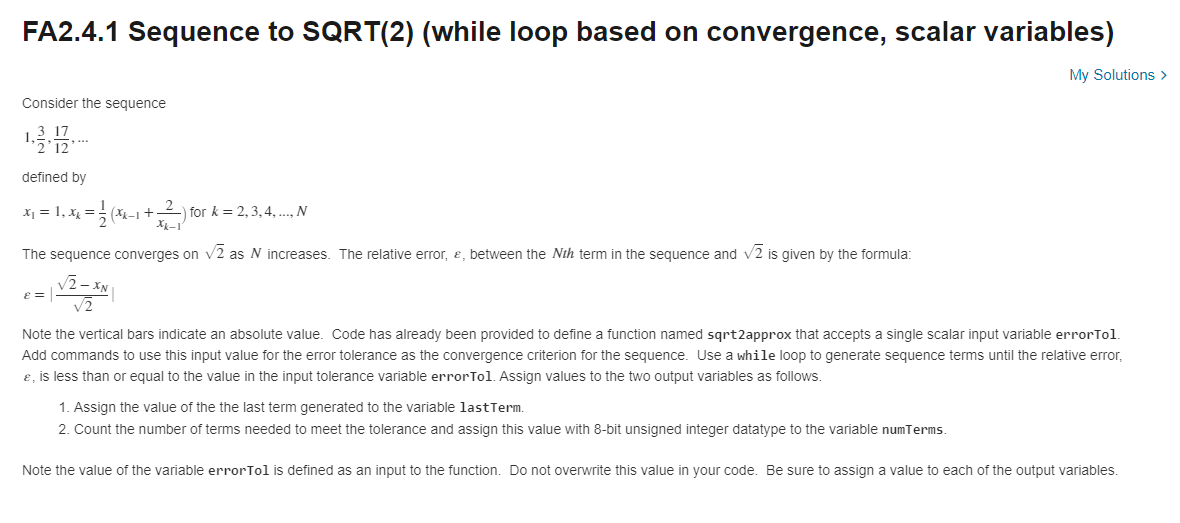Function e A Save C Reset I MATLAB Documentation 1 function [lastTerm, numTerms] = sqrt2approx(errorTol) %Enter the commands for your function here. % 4 % This function calculates terms of the sequence 5 % 6 % x(1) = 1 , x(k) = (x(k-1) + 2/x(k-1))/2 7 % 8 % until the relative error between the Nth term and sqrt(2) falls below 9 % a given tolerance. 10 % 11 % Input: 12 % errorTol - The tolerance used as the convergence criterion 13 % Output: - The last term in the sequence (that meets the tolerance) - The number of terms required to meet the tolerance 14 % lastTerm 15 % numTerms 16 Code to call your function e C Reset 1 [lastTerm, numTerms] = sqrt2approx(1e-5)
Function e A Save C Reset I MATLAB Documentation 1 function [lastTerm, numTerms] = sqrt2approx(errorTol) %Enter the commands for your function here. % 4 % This function calculates terms of the sequence 5 % 6 % x(1) = 1 , x(k) = (x(k-1) + 2/x(k-1))/2 7 % 8 % until the relative error between the Nth term and sqrt(2) falls below 9 % a given tolerance. 10 % 11 % Input: 12 % errorTol - The tolerance used as the convergence criterion 13 % Output: - The last term in the sequence (that meets the tolerance) - The number of terms required to meet the tolerance 14 % lastTerm 15 % numTerms 16 Code to call your function e C Reset 1 [lastTerm, numTerms] = sqrt2approx(1e-5)
Computer Networking: A Top-Down Approach (7th Edition)
7th Edition
ISBN:9780133594140
Author:James Kurose, Keith Ross
Publisher:James Kurose, Keith Ross
Chapter1: Computer Networks And The Internet
Section: Chapter Questions
Problem R1RQ: What is the difference between a host and an end system? List several different types of end...
Related questions
Question
![Function e
A Save
C Reset
I MATLAB Documentation
1 function [lastTerm, numTerms] = sqrt2approx(errorTol)
2 %Enter the commands for your function here.
3 %
4 % This function calculates terms of the sequence
5 %
6 %
x(1) = 1, x(k) = (x(k-1) + 2/x(k-1))/2
7 %
8 % until the relative error between the Nth term and sqrt(2) falls below
9 % a given tolerance.
10 %
11 % Input:
12 %
errorTol
- The tolerance used as the convergence criterion
13 % Output:
14 %
lastTerm
- The last term in the sequence (that meets the tolerance)
15 %
numTerms
The number of terms reguired to meet the tolerance
16
Code to call your function e
C Reset
1 [lastTerm, numTerms] = sqrt2approx(1e-5)](/v2/_next/image?url=https%3A%2F%2Fcontent.bartleby.com%2Fqna-images%2Fquestion%2F03a9ebbb-ca97-43d4-9de6-405a09147162%2F11cb8cb3-edce-4b95-a437-bb73b2d9172e%2Febrvy_processed.png&w=3840&q=75)
Transcribed Image Text:Function e
A Save
C Reset
I MATLAB Documentation
1 function [lastTerm, numTerms] = sqrt2approx(errorTol)
2 %Enter the commands for your function here.
3 %
4 % This function calculates terms of the sequence
5 %
6 %
x(1) = 1, x(k) = (x(k-1) + 2/x(k-1))/2
7 %
8 % until the relative error between the Nth term and sqrt(2) falls below
9 % a given tolerance.
10 %
11 % Input:
12 %
errorTol
- The tolerance used as the convergence criterion
13 % Output:
14 %
lastTerm
- The last term in the sequence (that meets the tolerance)
15 %
numTerms
The number of terms reguired to meet the tolerance
16
Code to call your function e
C Reset
1 [lastTerm, numTerms] = sqrt2approx(1e-5)

Transcribed Image Text:FA2.4.1 Sequence to SQRT(2) (while loop based on convergence, scalar variables)
My Solutions >
Consider the sequence
3 17
defined by
X1 = 1, x =
(니 +2) 1or k= 2,3,4 N
X-1
The sequence converges on v2 as N increases. The relative error, e, between the Nth term in the sequence and v2 is given by the formula:
Note the vertical bars indicate an absolute value. Code has already been provided to define a function named sqrt2approx that accepts a single scalar input variable errorTol
Add commands to use this input value for the error tolerance as the convergence criterion for the sequence. Use a while loop to generate sequence terms until the relative error,
ɛ, is less than or equal to the value in the input tolerance variable errorTol. Assign values to the two output variables as follows.
1. Assign the value of the the last term generated to the variable lastTerm.
2. Count the number of terms needed to meet the tolerance and assign this value with 8-bit unsigned integer datatype to the variable numTerms.
Note the value of the variable errorTol is defined as an input to the function. Do not overwrite this value in your code. Be sure to assign a value to each of the output variables
Expert Solution
This question has been solved!
Explore an expertly crafted, step-by-step solution for a thorough understanding of key concepts.
This is a popular solution!
Trending now
This is a popular solution!
Step by step
Solved in 2 steps with 2 images

Recommended textbooks for you

Computer Networking: A Top-Down Approach (7th Edi…
Computer Engineering
ISBN:
9780133594140
Author:
James Kurose, Keith Ross
Publisher:
PEARSON

Computer Organization and Design MIPS Edition, Fi…
Computer Engineering
ISBN:
9780124077263
Author:
David A. Patterson, John L. Hennessy
Publisher:
Elsevier Science

Network+ Guide to Networks (MindTap Course List)
Computer Engineering
ISBN:
9781337569330
Author:
Jill West, Tamara Dean, Jean Andrews
Publisher:
Cengage Learning

Computer Networking: A Top-Down Approach (7th Edi…
Computer Engineering
ISBN:
9780133594140
Author:
James Kurose, Keith Ross
Publisher:
PEARSON

Computer Organization and Design MIPS Edition, Fi…
Computer Engineering
ISBN:
9780124077263
Author:
David A. Patterson, John L. Hennessy
Publisher:
Elsevier Science

Network+ Guide to Networks (MindTap Course List)
Computer Engineering
ISBN:
9781337569330
Author:
Jill West, Tamara Dean, Jean Andrews
Publisher:
Cengage Learning

Concepts of Database Management
Computer Engineering
ISBN:
9781337093422
Author:
Joy L. Starks, Philip J. Pratt, Mary Z. Last
Publisher:
Cengage Learning

Prelude to Programming
Computer Engineering
ISBN:
9780133750423
Author:
VENIT, Stewart
Publisher:
Pearson Education

Sc Business Data Communications and Networking, T…
Computer Engineering
ISBN:
9781119368830
Author:
FITZGERALD
Publisher:
WILEY